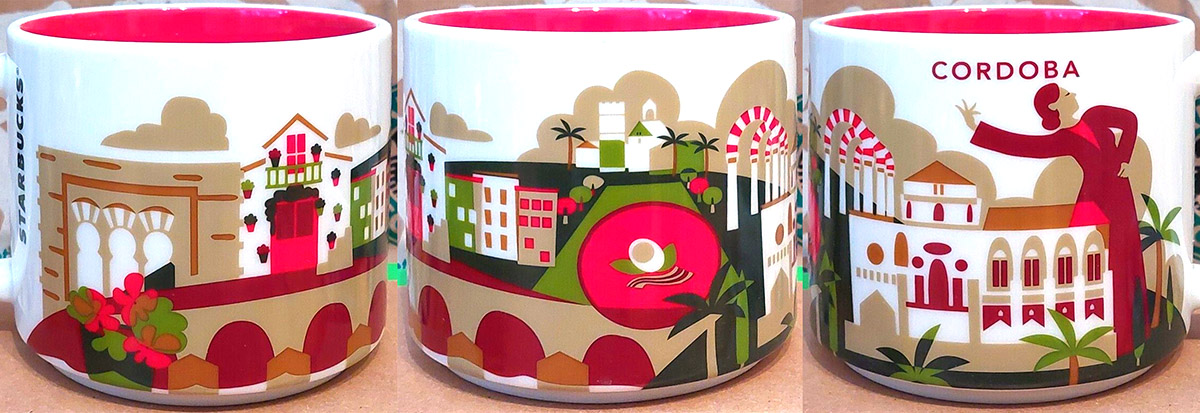
You Are Here – Cordoba
Starbucks You Are Here – Córdoba is a mug for a Spanish city nestled in the heart of Andalusia. From its ancient roots as a Roman settlement to its golden age as the capital of Moorish Spain, Córdoba has witnessed the ebb and flow of civilizations, each leaving an indelible mark on its landscape and character.
Córdoba’s history dates back over two millennia, with evidence of human settlement found as early as the Neolithic period. However, it was under Roman rule that Córdoba truly flourished, becoming an important provincial capital known as Corduba. The Romans constructed magnificent structures, including a grand temple dedicated to Emperor Claudius.
In the 8th century, Córdoba fell under Moorish rule during the Islamic conquest of the Iberian Peninsula. Under the Umayyad Caliphate, Córdoba blossomed into one of the most advanced and prosperous cities in Europe. Its crowning jewel, the Great Mosque of Cordoba (Mezquita), was constructed during this period, showcasing exquisite Islamic architecture and craftsmanship.
Following the Reconquista, Córdoba became part of Christian Spain in the 13th century. Despite the changes in rulership, Córdoba retained its cultural diversity and architectural splendor, with Christian monarchs adding their own embellishments to the city.
The front of the mug showcases the Mosque-Cathedral of Córdoba, also commonly referred to as the Mezquita or the Great Mosque of Córdoba. It stands as an architectural masterpiece and a symbol of Cordoba’s rich cultural heritage. Originally constructed as a mosque during the Islamic period, its stunning blend of Moorish, Gothic, and Renaissance elements reflects the city’s diverse history. The highlight of this iconic landmark is its expansive prayer hall adorned with a mesmerizing forest of columns and horseshoe arches, creating an atmosphere of serenity and grandeur (you can see this stunning hall on the back of the mug). Following the Reconquista, a cathedral was built within the mosque’s structure, adding another layer of complexity to its design. Today, the Mosque-Cathedral of Córdoba stands as a testament to the city’s unique synthesis of Islamic and Christian traditions, captivating visitors with its beauty and historical significance.
The dancer on the front of the mug is probably a reference to Flamenco, which is a captivating and emotional art form that originated in the southern regions of Spain, particularly Andalusia. It is comprised of three main components: guitar playing (“guitarra”), song (“cante”), and dance (“baile”). Flamenco dancing is a highly expressive style that aims to convey deep emotions through body movements, facial expressions, and percussive footwork. The history of flamenco dates back to the 18th century, and its development is intertwined with the cultural influences of various world traditions. Flamenco is not only a form of entertainment but also a powerful means of artistic expression that evokes deep emotions and reflects the rich cultural heritage of Spain
The Roman Bridge (Puente Romano), spanning the Guadalquivir River, is an iconic symbol of Cordoba’s Roman past. It offers stunning views of the city and is a popular spot for leisurely walks.
The Alcazar de los Reyes Cristianos, nestled in the heart of the city, stands as a testament to centuries of history and cultural exchange. Originally constructed as a fortress by the Moorish rulers, it later became a royal residence for Spanish monarchs during the Reconquista. Its imposing walls and majestic towers bear witness to the city’s tumultuous past, while its lush gardens and tranquil courtyards offer a peaceful retreat from the bustling streets. Visitors to the Alcazar can explore its rich architectural heritage, from the Mudejar-style baths to the Renaissance-inspired palace chambers. With its blend of Islamic, Christian, and Mudejar influences, the Alcazar de los Reyes Cristianos remains an enduring symbol of Cordoba’s multicultural legacy and architectural splendor.



































































